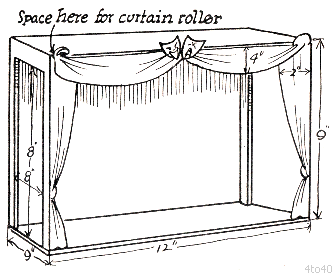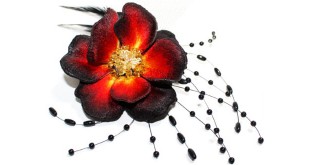 Making a Model Theatre – Most boys love making a model theatre so that they can produce a play with cut out characters performing the parts. These model theaters give endless entertainment at parties and a great deal of pleasure can be had even by the making of the model.
Making a Model Theatre – Most boys love making a model theatre so that they can produce a play with cut out characters performing the parts. These model theaters give endless entertainment at parties and a great deal of pleasure can be had even by the making of the model.
The actual framework of the theatre is best constructed with wood, so that it will be quite rigid and will stand a lot of use. A good average size is I2 in. wide by 9 in. high and having a depth of 9 in. Make the framework of the stage by starting with a piece of plywood for the back, measuring I2 in. by 9 in. The base and stage for the theatre is the next step and this will require another length of plywood with the overall length of I8 in. and having a width of I2 in. The top of the theatre should measure 9 in. wide. Both the sides of the theatre should measure 9 in. wide and have a length of 9 in. There will be a piece cut out from the centre of each side, measuring 8 in. wide and having a depth of 8 in. This can be seen clearly in the diagram. These pieces can be cut with a small saw or fret-saw. Before assembling the parts together, give the edges a good sandpapering so that they are smooth and well finished.
Assemble the stage and base using very thin nails along the edges, after giving the joints a coating of gum. This will complete the basic framework of the theatre and you will now need the ornate front as pictured in the diagram. For this you will require two pieces of plywood for the side curtains and a I2 in. long piece for the top. Make the top first, pencil the shape of the curtain on the lines of the illustration, making this about 4 in. deep. The design can then be cut out with a fret-saw and the edges sandpapered to a rounded smoothness.
The two side curtains are also cut out after pencilling the shape on the surface. The maximum width of each side curtain should not be more than 2 in. wide. Copy the design of the folded curtains as near as possible and then cut round the edges with a fret-saw and sandpaper well. Gum and nail the two sides to the framework first of all, and attach the top piece over the sides, allowing the top to protrude above. The placing of this is shown clearly in the diagram.
There is no necessity to paint the inside or top of the theatre, for this is not seen from the front of the stage. You need only paint the top and side curtains, using a brilliant red enamel paint for the curtains, and show the folds in black. The two shields on the top can be painted in a light yellow, with the masks out lined in black.
Paint the stage a light yellow to imitate the boards and paint the surrounds of the base in black so as to give a good contrast to the stage. To improve the finish of the model theatre varnish all over and when this is quite dry, the model is ready for the scenery and the players.
 Kids Portal For Parents India Kids Network
Kids Portal For Parents India Kids Network






